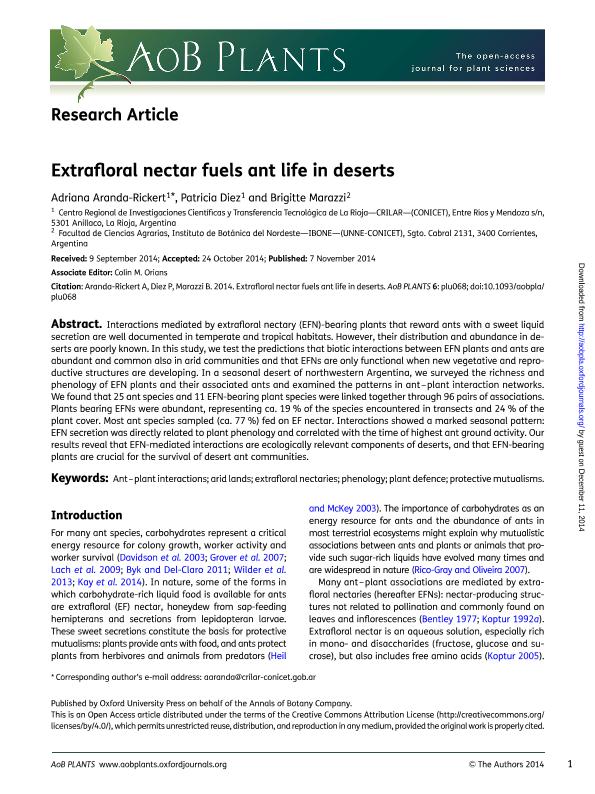Artículo
Extrafloral nectar fuels ant life in deserts
Fecha de publicación:
07/11/2014
Editorial:
Oxford University Press
Revista:
Annals of Botany Plants
ISSN:
2041-2851
Idioma:
Inglés
Tipo de recurso:
Artículo publicado
Clasificación temática:
Resumen
Interactions mediated by extrafloral nectary (EFN)-bearing plants that reward ants with a sweet liquid secretion are well documented in temperate and tropical habitats. However, their distribution and abundance in deserts are poorly known. In this study, we test the predictions that biotic interactions between EFN plants and ants are abundant and common also in arid communities and that EFNs are only functional when new vegetative and reproductive structures are developing. In a seasonal desert of northwestern Argentina, we surveyed the richness and phenology of EFN plants and their associated ants and examined the patterns in ant–plant interaction networks. We found that 25 ant species and 11 EFN-bearing plant species were linked together through 96 pairs of associations. Plants bearing EFNs were abundant, representing ca. 19 % of the species encountered in transects and 24 % of the plant cover. Most ant species sampled (ca. 77 %) fed on EF nectar. Interactions showed a marked seasonal pattern: EFN secretion was directly related to plant phenology and correlated with the time of highest ant ground activity. Our results reveal that EFN-mediated interactions are ecologically relevant components of deserts, and that EFN-bearing plants are crucial for the survival of desert ant communities.
Archivos asociados
Licencia
Identificadores
Colecciones
Articulos(CRILAR)
Articulos de CENTRO REGIONAL DE INV. CIENTIFICAS Y TRANSFERENCIA TECNOLOGICA DE ANILLACO
Articulos de CENTRO REGIONAL DE INV. CIENTIFICAS Y TRANSFERENCIA TECNOLOGICA DE ANILLACO
Articulos(IBONE)
Articulos de INST.DE BOTANICA DEL NORDESTE (I)
Articulos de INST.DE BOTANICA DEL NORDESTE (I)
Citación
Aranda Rickert, Adriana Marina; Diez, Patricia Alejandra; Marazzi, Brigitte; Extrafloral nectar fuels ant life in deserts; Oxford University Press; Annals of Botany Plants; 6; 68; 7-11-2014; 1-14
Compartir
Altmétricas




